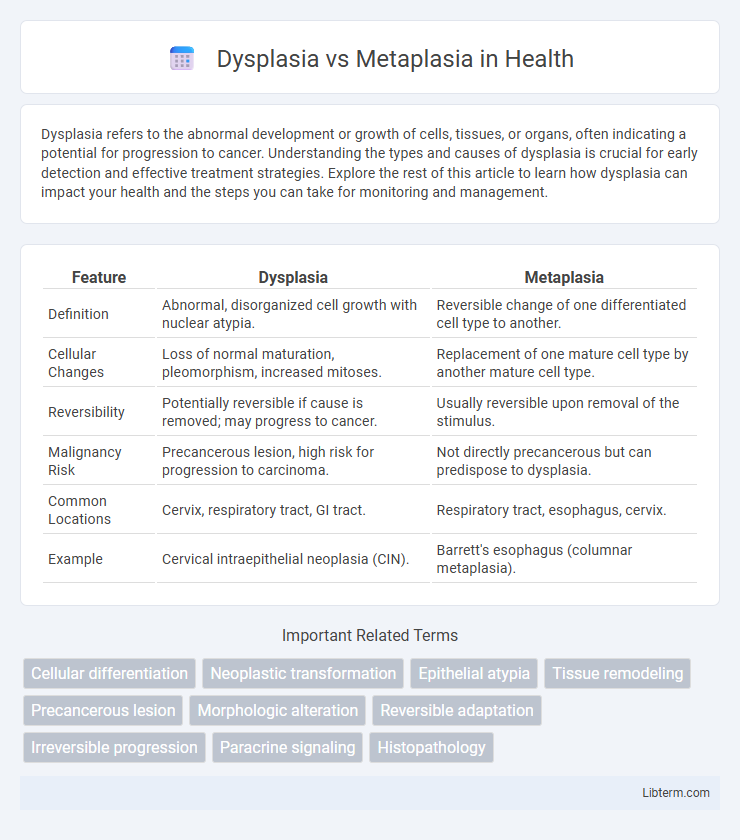Dysplasia refers to the abnormal development or growth of cells, tissues, or organs, often indicating a potential for progression to cancer. Understanding the types and causes of dysplasia is crucial for early detection and effective treatment strategies. Explore the rest of this article to learn how dysplasia can impact your health and the steps you can take for monitoring and management.
Table of Comparison
| Feature | Dysplasia | Metaplasia |
|---|---|---|
| Definition | Abnormal, disorganized cell growth with nuclear atypia. | Reversible change of one differentiated cell type to another. |
| Cellular Changes | Loss of normal maturation, pleomorphism, increased mitoses. | Replacement of one mature cell type by another mature cell type. |
| Reversibility | Potentially reversible if cause is removed; may progress to cancer. | Usually reversible upon removal of the stimulus. |
| Malignancy Risk | Precancerous lesion, high risk for progression to carcinoma. | Not directly precancerous but can predispose to dysplasia. |
| Common Locations | Cervix, respiratory tract, GI tract. | Respiratory tract, esophagus, cervix. |
| Example | Cervical intraepithelial neoplasia (CIN). | Barrett's esophagus (columnar metaplasia). |
Introduction to Dysplasia and Metaplasia
Dysplasia refers to the abnormal development and disordered growth of epithelial cells characterized by variations in size, shape, and organization, often considered a precancerous condition. Metaplasia involves the reversible transformation of one differentiated cell type into another, typically as an adaptive response to chronic irritation or inflammation. Both dysplasia and metaplasia signify cellular alterations but differ in their pathological significance and potential for malignancy.
Defining Dysplasia: Key Characteristics
Dysplasia is characterized by abnormal cell growth and differentiation, often indicating a precancerous condition with potential for malignant transformation. Key features include cellular pleomorphism, increased mitotic activity, and loss of normal tissue architecture. Unlike metaplasia, which involves reversible replacement of one mature cell type by another, dysplasia reflects disorganized and atypical cellular proliferation confined to the epithelium.
Defining Metaplasia: Key Characteristics
Metaplasia is a reversible process characterized by the transformation of one differentiated epithelial or mesenchymal cell type into another type better suited to withstand environmental stress, often triggered by chronic irritation or inflammation. Unlike dysplasia, which involves abnormal cellular growth and architectural disorganization with potential progression to malignancy, metaplasia maintains normal cellular architecture but changes cell phenotypes. Common examples of metaplasia include Barrett's esophagus, where esophageal squamous epithelium transforms into intestinal-type columnar epithelium, and respiratory tract columnar epithelium changing to squamous epithelium in response to smoking.
Cellular Mechanisms: Dysplasia vs Metaplasia
Dysplasia involves abnormal cellular proliferation with loss of normal tissue architecture, characterized by increased nuclear atypia, pleomorphism, and mitotic figures, often indicating a premalignant state. Metaplasia represents a reversible change where one differentiated cell type is replaced by another, typically as an adaptive response to chronic irritation or inflammation, without the atypical nuclear changes seen in dysplasia. Cellular mechanisms in dysplasia reflect genetic mutations affecting cell cycle regulation and apoptosis, whereas metaplasia involves reprogramming of stem cells or progenitor cells driven by altered signaling pathways like TGF-b and BMP.
Etiological Factors and Risk Influences
Dysplasia and metaplasia are cellular adaptations with distinct etiological factors and risk influences; dysplasia often arises from chronic inflammation, persistent infections (such as HPV in cervical tissue), and exposure to carcinogens like tobacco smoke, which cause genetic mutations and abnormal cell growth. Metaplasia results from chronic irritation or inflammation, such as gastroesophageal reflux leading to Barrett's esophagus, where one differentiated cell type is replaced by another better suited to withstand the stress. Both conditions increase cancer risk, but dysplasia represents a more advanced pre-neoplastic state compared to metaplasia.
Histopathological Features: Comparison
Dysplasia exhibits disorganized cellular architecture, nuclear pleomorphism, hyperchromasia, and an increased mitotic rate indicating premalignant changes, while metaplasia involves the reversible replacement of one differentiated cell type by another without significant atypia or mitotic abnormalities. Histopathologically, dysplastic tissues show loss of normal maturation and stratification, often with enlarged, irregular nuclei, contrasting with metaplastic tissues which maintain normal cellular morphology despite altered cell types. The presence of abnormal mitoses and disrupted tissue polarity in dysplasia distinguishes it from the structurally preserved and orderly cellular arrangement seen in metaplasia.
Clinical Significance and Outcomes
Dysplasia represents abnormal cellular growth with a high potential for progression to cancer, often requiring close clinical monitoring or intervention. Metaplasia involves reversible replacement of one mature cell type with another, typically as an adaptive response to chronic irritation, and carries a lower risk of malignancy. Early identification of dysplastic changes enables timely treatment, reducing the likelihood of invasive carcinoma and improving patient outcomes.
Reversibility: Metaplasia vs Dysplasia
Metaplasia is generally reversible when the underlying cause is removed, allowing the affected tissue to return to its original state. Dysplasia represents an abnormal cellular development that may be reversible in early stages but often indicates a pre-cancerous condition with a higher risk of progression to malignancy if left untreated. Understanding the degree of reversibility in metaplasia versus dysplasia is critical for timely intervention and prevention of cancerous transformation.
Management and Treatment Approaches
Dysplasia requires close monitoring and often involves biopsy followed by surgical excision or ablative therapies to prevent progression to carcinoma, with treatment intensity based on the grade of abnormality. Metaplasia management primarily focuses on eliminating the underlying cause, such as controlling chronic irritation or reflux, and may involve pharmacologic interventions like proton pump inhibitors to reverse tissue changes. Regular surveillance with endoscopic evaluation is crucial in both conditions to detect progression or regression and guide timely therapeutic decisions.
Conclusions: Distinguishing Dysplasia from Metaplasia
Dysplasia is characterized by disorganized cellular architecture and abnormal nuclear features indicative of neoplastic transformation, whereas metaplasia involves a reversible change in cell type adapting to environmental stress without atypia. Accurate differentiation relies on histopathological evaluation of cellular morphology and an assessment of cellular atypia, proliferation, and tissue organization. Recognizing these distinctions is critical for prognosis and therapeutic decisions, as dysplasia often represents a premalignant state while metaplasia is typically benign and reversible.
Dysplasia Infographic

 libterm.com
libterm.com